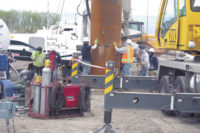
Braun Intertec, Minneapolis, used its Geoprobe 7720DT and 6620DT rigs to collect environmental samples on a 10-mile stretch of roadway prior to construction of the new Central Corridor Light Rail Transit (CCLRT) line. The rail line, which will run through a mix of neighborhoods, commercial and industrial areas, will offer commuter service between Minneapolis and St. Paul – Minnesota’s two largest cities. The CCLRT line should begin service in 2014.
According to Greg Bialon, Braun Intertec’s drilling manager, the overall versatility, power and size of the 7720DT made it a good match for the project. “We needed something with versatility to go off-road and use in a variety of settings,” Bialon explains, “but still narrow enough to collect soil samples from inside buildings. We were extremely pleased with how it performed on the project.” The 6620DT, a smaller version of the 7720DT, provided additional assistance on the job.
During a 100-day period, two Braun Intertec field teams collected soil and ground water samples from about 500 borings along the proposed rail line. “Having two rigs on the job helped keep the drilling on schedule,” says Jaclyn Dylla, a project manager for Braun Intertec. “We assigned two field scientists to each rig to keep up with the large amount of footage produced during this fast-paced project.” The alignment where the two teams were drilling is densely populated with heavy pedestrian, car and bus traffic. Most of the borings involved penetration through roadways with underlying urban fill to depths of 20 feet to 40 feet. “The average boring depth was about 25 feet,” notes Dylla. “Each field team drilled about 150 feet per day.”
The small footprint of the rigs, which is smaller than a regular pickup truck, was a real plus while working in high-traffic areas along the CCLRT line. “We could easily park the rigs at an angle while staying inside of a closed driving lane, and still get the subsurface information we needed,” says Dylla.
The field teams drilled approximately 12,000 feet during the project, and collected about 900 soil and ground water samples. The samples were analyzed in the Braun Intertec analytical laboratory. On-site field computers allowed the field crews to draft and publish boring logs, field notes and other important information and documents for clients in a near real-time basis. The electronic documentation was uploaded, along with boring information, onto a searchable project web portal called Braun Interport Custom.
The estimated project cost for the CCLRT is $957 million. Project designers forecast an average weekday ridership of 40,000 by the year 2030.
ND



